DISCOVERING THE ANCIENT TOWN OF SOISSONS – A GREAT DAY TRIP FROM PARIS
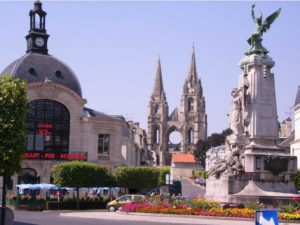
The town of Soissons in Picardy, designated a City of Art and History, has deep, obscure roots that date back to ancient Gaul. It occupied a strategic location, much fought over by Caesar and his Roman legions and the Gallic tribes, and later became an important city in the Frankish Empire, eventually becoming its capital—the first of France. If you enjoy discovering little-known destinations that offer important historic monuments, a magnificent Gothic cathedral, and dramatic experiences during both world wars of the 20th century, then you will find a visit to Soissons a very rewarding experience.

The delightful medieval town of Soissons, located 100 kms N.E. of Paris, lies on the river Aisne. It’s about an hour by train from Paris Gare du Nord, making it the ideal destination for a day trip from the capital.
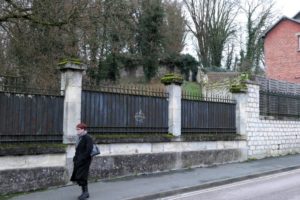
Soissons first appeared in written history under its Celtic name, later borrowed into Latin, Noviodunum, meaning “new hill fort”, which was the capital of the Suessiones tribe from Belgian Gaul. In his Commentaries of 57 BC, Julius Caesar noted that after one long day’s march, they entered the territory of the Suessiones, Noviodunum, which was surrounded by a high wall and a broad ditch. The town surrendered to Caesar, renamed “Augusta Suessionum” under the Emperor Augustus, and became a garrison town. There is actually a Roman theatre in Soissons, but it’s still mostly covered in earth and inaccessible to the public, more’s the pity, although there’s a small plaque at the site marking its location.
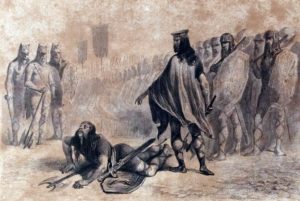
From 457 to 486, under Aegidius and his son Syagrius, the town was the capital of the Domain of Soissons, an independent province of the Western Roman Empire, until it fell to the Frankish king Clovis l in the Battle of Soissons in 486. Clovis was the first king of the Franks to unite all the Frankish tribes under one ruler, changing the form of leadership from a group of petty kings to rule by a single king, and also ensured that the kingship was passed down to his heirs. He is considered to have been the founder of the Merovingian dynasty, which ruled the Frankish kingdom for the next 2 centuries.

After Clovis’ death, his 4 sons split the Merovingian kingdom between themselves, and Soissons became the capital of Clotaire l. In 751, Pepin the Short was anointed King of the Franks in Soissons by Boniface, Archbishop of Mainz. After another brief period of unification, the Frankish kingdom was split again, and suffered numerous invasions and devastations during the following 200 years.

Under the Capetian dynasty, the town was held by the hereditary counts of Soissons from 969, with the title passing through various noble families, including, since the 15th century, the Bar, the Luxembourg, the Bourbon and the Savoy. The last Count of Soissons died heirless in 1734. Soissons hosted the Congress of Soissons in 1728 which was an attempt to resolve a long-standing series of disputes between the Kingdom of Great Britain and Spain, which had spilled over into the Anglo-Spanish War of 1727-29. This Congress was largely successful and led to the signing of the Treaty of Seville between the two warring countries.
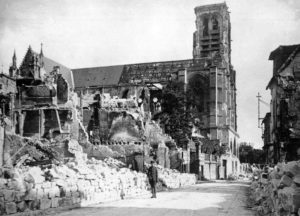
During WWl the town came under heavy bombardment, due to its strategic importance and its close proximity to Paris, which made it a last line of defence before reaching the capital.
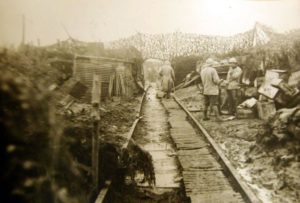
The nearby Chemin des Dames ridge saw 3 important battles, acknowledged as some of the most savage battles on the Western Front. The ridge had been quarried for stone for centuries, leaving many caves and tunnels which were used as shelters by German troops to escape bombardment. The worst of these battles saw massive casualties on both sides, especially the ferocious Second Battle of the Aisne in 1917. The town was finally captured by the Germans in May 1918 and recaptured again in August of the same year. Today one can see a statue erected near the Church of St Peter next to the Soissons courthouse, with images of French soldiers killed in action in 1917. Although Soissons was severely damaged during WWl and to a lesser extent in WW2, most of the historic buildings for which it is famous have been restored.

Soissons’ main claim to fame these days is the Cathedral Saint-Gervais Saint-Protais, built between the 12th and 14th centuries, known simply as Soissons Cathedral. A Christian diocese existed here since the 4th century, although the present cathedral sits on a site where a church has existed since the 9th century. Rodin famously declared that “there are no hours in this cathedral, but rather eternity.”
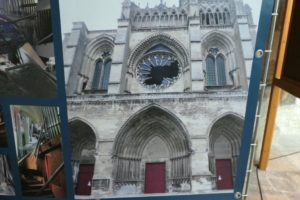
The first thing the catches the eye is its asymmetrical, one-tower façade—the second tower never having been built. However, the Gothic interior, with its pure lines and restrained ornamentation, creates a more harmonious impression. The most remarkable feature though, is the rounded four-storey southern transept that, according to experts, is an element more frequently found in the German Rhineland than in France. Rubens’ luminous ‘Adoration of the Shepherds’ hangs high on the other side of the transept, and there are beautiful 13th century stained glass windows towards the choir.
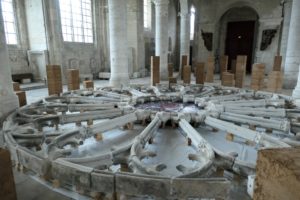
On 12 January 2017 a severe storm swept through Soissons and the gale-force winds blew out the massive rose window of the cathedral. What’s there today is a reproduction of the original, but interestingly, the stones of the damaged window were carefully removed and now are on display, laid out as a rose window, on the floor of the city museum, housed in the former Abbaye Saint-Leger. It’s a fascinating experience to be “up close and personal” with an original Gothic window!
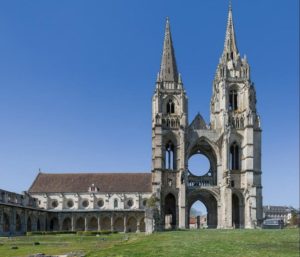
Aside from the Gothic cathedral, surely the city’s most compelling sight would be the ruins of the Abbey of Saint-Jean des Vignes. Its spires are in fact taller, and perhaps more impressive, than that of the cathedral. The abbey was founded in 1075 on a hilltop, and became one of the richest in medieval France. It was largely destroyed in 1805 under Napoleon I, but the famous façade (13th-16th century) was spared and the remaining ruins in the Flamboyant Gothic style are still very impressive. Its two asymmetrical towers—one is 80 m. high while the other is 75m—surmounted by stone spires, can be seen from afar, and dominate the city.

There are a number of buildings scattered across the site, one of which, built in 1878, was used as an arsenal during WWl, when the site became a military outpost for French military. This magazine, in which up to 36,600 kgs of gunpowder were once stored, is a now cultural centre for the town.
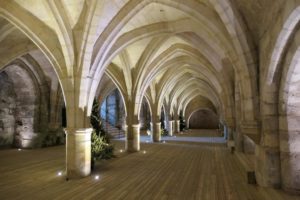
The cellars of the abbey are now used as a concert hall and an art gallery where local artists can display their work.
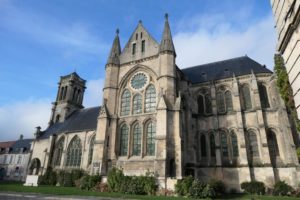
Located right in town is another beautiful example of religious architecture, the 12th century Abbaye Saint-Léger, named in honour of the 7th century Bishop of Autun whose mother had retired to Soissons’ Notre-Dame Abbey. The traceries and vaults in the cloister’s north gallery are exquisite, and are a designated Monument Historique.
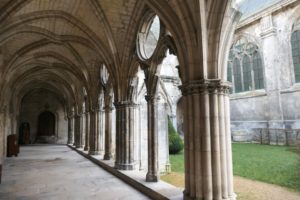
Be sure to also see the cloister, chapel and crypt. As mentioned above, the Musée Municipal de Soissons is now housed in the former Abbaye, and its collection consists of fascinating items of local history and archaeology and a gallery of very fine paintings. The museum moved to the Abbaye in the 1930s, but many of collections were assembled much earlier, in the 1850s, when the museum had been set up in the Hotel de Ville. You can see architectural fragments, Gallo-Roman marbles, ceramics, glassware and jewellery as well as maps and illustrations showing how the town has evolved.
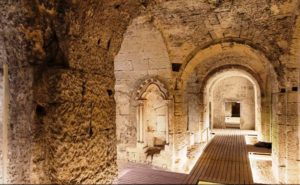
The Abbey of Saint-Médard de Soissons was a Benedictine monastery, at one time held to be the greatest in France. Founded in 557 by Clotaire l on his manor of Crouy, just outside the then boundaries of Soissons to house the remains of Saint Medard. Legend has it that during the funeral procession, the bier came to a standstill at Crouy and was impossible to move until the king had made a gift of the whole estate for the foundation of the abbey. Besides St. Medard, kings Clotaire l and Sigebert l were also buried here. In 751 Childeric lll was deposed here, and Pippin the Short crowned. Various other relics were deposited here, including those of St. Sebastian, St. Gregory the Great, St Gildard and St. Remigius.

The wealth of the abbey was immense. In the 12th century the community owned about 220 fiefs (estates). The abbey also minted coins. Its wealth remained into the 16th century, but the abbey was destroyed in 1567 during the Wars of Religion, and although it was restored in 1637, it never regained its former stature. The abbey was dissolved during the Revolution, and today, only the crypt and a small segment of its fortifications remain.
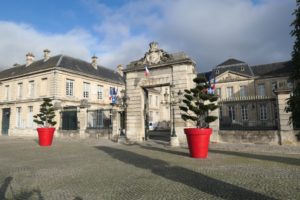
You can’t miss the Hotel de Ville, built originally as the château of the Intendant (representative of the King) in the 1770s, and built on the site of a previous château belonging to the Counts of Soissons. It became the Hotel de Ville in 1833.
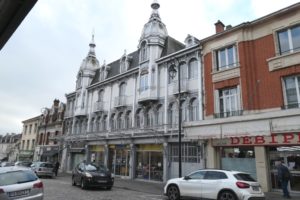
Despite terrible damage sustained during WWl, the most important houses and monuments were restored, while much of the city was simply rebuilt in the new Art Deco style, which is visible in the bold geometric shapes of many façades and whimsical motifs carved into the stone.
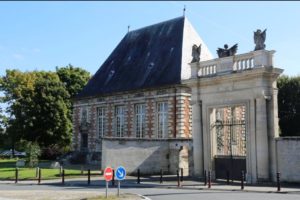
A footbridge over the river Aisne in the centre of the town was destroyed in 1914 and rebuilt by British soldiers, after which it was known as the Pont des Anglais. Destroyed again during WWll, it was rebuilt in 1950 as a pedestrian bridge, and renamed the Passerelle des Anglais. Also check out the pretty little Pavillon de l’Arquebuse dating to 1626 and designed in the Louis Xlll style.
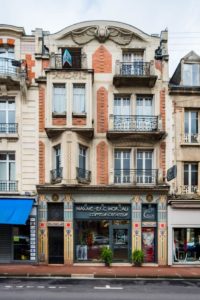
As so many buildings were destroyed during heavy bombardment in WWl, a number were rebuilt in the new, modern style, which we now refer to as Art Deco. An outstanding example of this style can be seen in the so-called Maison Egyptienne in rue du College, built in 1923. The façade, as one description has it, is pure ‘Egyptomania’, with decorated bas-reliefs, roof terraces and beautiful mosaics on its lower floors.
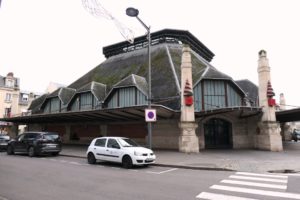
Also, don’t miss the impressive Marché Couvert (covered market) in town built in 1908. It has an excellent market on Wednesday and Saturday mornings, including a good range of Picardy’s artisan delicacies.
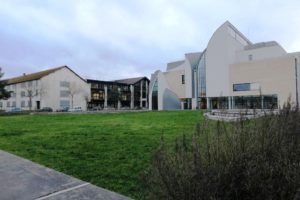
Although Soissons celebrates and cares for its historic buildings and history, nevertheless it is a thriving modern town with a vibrant cultural life. This can be seen by the impressive modern Conservatoire, constructed on a large area of defunct industrial land opposite the ruins of the Abbaye St Jean des Vignes site. It’s worth strolling around this interesting complex that caters to music, dance and all aspects of the performing arts.
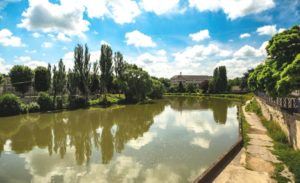
Soissons, even without its fascinating history and many fine historic buildings, is a delightful town in which to spend time strolling through the little streets and along some of the picturesque riverside walks, and simply enjoying the atmosphere that centuries of human activity has created.
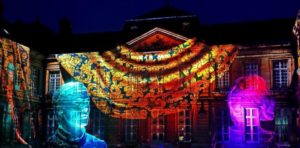


Leave a Reply